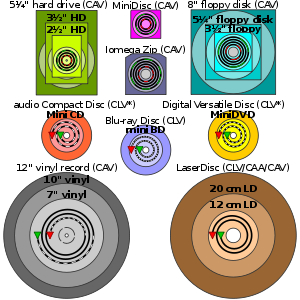- Constant linear velocity
-
In optical storage, constant linear velocity (CLV) is a qualifier for the rated speed of an optical disc drive, and may also be applied to the writing speed of recordable discs. CLV implies that the angular velocity (i.e. rpm) varies during an operation, as contrasted with CAV modes. The concept of constant linear velocity was patented in 1886 by phonograph pioneers Chichester Bell and Charles Tainter.
An audio CD employs constant linear velocity to maintain both a constant data rate and a constant bit density. At 1x speed the motor decreases from 495 to 212 rpm as the read head moves away from the center (which is the start of the recording), to keep the disc moving past the read head at a CLV of 1.2 m/s.
To accommodate the higher data transfer rates and random access requirements of modern CD-ROM drives, CAV systems are used. This is because seek performance would be greatly affected during random access by the requirement to continually modulate the disc's rotation speed to be appropriate for the read head's position.
Zoned Constant Linear Velocity
Zoned Constant Linear Velocity (ZCLV) is a modification of CLV for high speed CD and DVD recorders. Early model recorders were CLV drives. The recording speed on such drives was rated in multiples of 150 KiB/s; a 4X drive, for instance, would write steadily at around 600 KiB/s. The transfer rate was kept constant by having the spindle motor in the drive vary in speed and run about 2.5 times as fast when recording at the inner rim of the disc as on the outer rim. Some high-speed recorders use the zoned CLV method (ZCLV), which divides the disc into stepped zones, each of which has its own constant linear velocity. At higher speeds, ZCLV offers a compromise between CAV, which enables faster seek times, and CLV, which enables greater storage capacity. A ZCLV recorder rated at "52X", for example, would write at 20X on the innermost zone and then progressively step up to 52X at the outer rim.
Constant Angular Acceleration
Constant Angular Acceleration (CAA) is a variant of CLV that was used on the Laserdisc format. The initial specification of CLV (as it applied to laserdisc) resulted in several playback artifacts to be present in the audio/video portion as well as compatibility problems with laserdisc players as produced by different manufacturers.
In the mid 1980s, Pioneer Electronics introduced the CAA scheme where the speed in rotation of the laserdisc was lowered in steps and eliminated most playback artifacts and compatibility problems. Since its introduction, most manufacturers of laserdiscs adopted the CAA format but still referred to their CAA-encoded product as CLV.
See also
- Constant angular velocity (CAV)
- Zone bit recording (ZCAV)
Categories:- Rotating disc computer storage media
- Audio storage
- Video storage
- Optical computer storage
Wikimedia Foundation. 2010.


